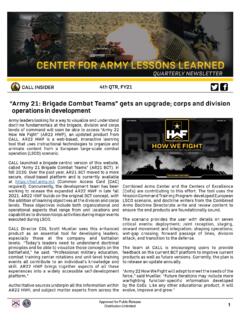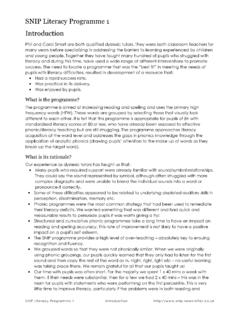Transcription of CAN with Flexible Data-Rate - can-newsletter.org
1 CAN with Flexible Data-RateSpecificationVersion (released April 17th, 2012)FD Copyright 2011, Robert Bosch GmbH, Robert Bosch Platz 1, 70839 Gerlingen, GermanyApril 2012page 1 RecitalThe acceptance and introduction of serial communication to more and more applica-tions has led to increasing demand for bandwidth in CAN communication and causedsystem developers to look for alternative communication options in certain applications can be realized more comfortably with the new protocol CAN FDthat allows data rates higher than 1 MBit/s and payloads longer 8 bytes per FD shares the physical layer.
2 With the CAN protocol as defined in the BOSCHCAN Specification The frame format however, is different. There are two new con-trol bits in the CAN FD frame, the first enabling the new frame format with different datalength coding and the second optionally switching to a faster bit rate after the arbitrationis decided. New CRC polynomials are introduced to secure the longer CAN FD frameswith the same Hamming distance as in the proven CAN CAN FD frame format has been defined so that messages in CAN frame formatand in CAN FD frame format can coexist within the same network.
3 The BOSCH CANS pecification remains valid without any modification as an independent, self-con-tained CAN bus protocol specification. The coexistence is assured by the requirement,that in order to be compatible with this CAN FD specification it is required that aCAN FD implementation be compatible with this CAN FD specification as well as withthe BOSCH CAN Specification order to be compatible with this CAN FD specification it is required that a CAN FDimplementation be compatible with this specification as well as with ISO.
4 CAN FD implementations that are designed according to this specification andCAN implementations that are designed according to the BOSCH CAN Specification communicate with each other as long as it is not made use of the CAN FD frameformat. This enables CAN systems to migrate gradually into CAN FD systems. In theintroductory phase, it is possible to use CAN FD only in specific operation modes, at end-of-line programming, while other controllers that do not sup-port CAN FD are kept in standby. Copyright 2011, Robert Bosch GmbH, Robert Bosch Platz 1, 70839 Gerlingen, GermanyApril 2012page 21 Introduction.
5 32 Basic Concepts .. 53 Message Transfer .. Frame Formats .. Frame Operation Modes .. 194 Message Validation .. Message Filtering .. 215 Coding .. 226 Error Error Error Signalling .. 237 Fault Confinement .. 248 Bit Timing Requirements .. Transceiver Delay 309 CAN FD Implementation .. 32 Copyright 2011, Robert Bosch GmbH, Robert Bosch Platz 1, 70839 Gerlingen, GermanyApril 2012page 3 Introduction1 INTRODUCTIONCAN FD is a serial communications protocol which efficiently supports distributed real-time control with a very high level of intention of this specification is to achieve compatibility between any two CAN FDimplementations.
6 Compatibility, however, has different aspects regarding electricalfeatures and the interpretation of data to be transferred. To achieve design transpar-ency and implementation flexibility CAN FD has been subdivided into different layersaccording to the ISO/OSI Reference Architecture of CANFD according to the OSI Reference ModelThe scope of this specification is to define the MAC sublayer and a small part of theLLC sublayer of the Data Link Layer as well a part of the Physical Layer and to describethe consequences of the CAN protocol on the surrounding Link LayerPhysical LayerLLCL ogical Link ControlMAC Medium Access ControlAcceptance
7 FilteringOverload NotificationRecovery ManagementData Encapsulation/DecapsulationFrame Coding (Stuffing, Destuffing)Medium Access ManagementError DetectionError SignallingAcknowledgmentSerialization / DeserializationBit Encoding/DecodingBit TimingSynchronizationDriver/Receiver CharacteristicsFaultConfinementBus FailureManagementSupervisorIntroduction Copyright 2011, Robert Bosch GmbH, Robert Bosch Platz 1, 70839 Gerlingen, GermanyApril 2012page 4 Data Link LayerThe Data Link Layer handles frames and consists of the two sublayers: Logical Link Control (LLC) Medium Access Control (MAC)LLC sublayer of the Data Link LayerThe LLC corresponds to the node s controller-host interface and is concerned with Mes-sage Filtering, Overload Notification and Recovery Management.
8 Its scope is to decide which messages received by the MAC sublayer are actually to beaccepted, to provide services for data transfer and for remote data request, to provide messages to the MAC sublayer for transmission, to provide means for recovery management and overload is much freedom in defining object sublayer of the Data Link LayerThe MAC sublayer is responsible for Message Framing, Arbitration, Acknowledgment,Error Detection and Signalling. It is supervised by a management entity called FaultConfinement which is a self-checking mechanism for distinguishing short disturbancesfrom permanent failures.
9 Within the MAC sublayer it is decided whether the bus is freefor starting a new transmission or whether a reception is just starting. The MAC sub-layer represents the kernel of the CAN FD protocol. It is in the nature of the MAC sub-layer that there is no freedom for LayerThe Physical Layer handles bits and defines how signals are actually transmitted andtherefore deals with the description of Bit Timing, Bit Encoding, and this specification the electrical driver/receiver characteristics of the PhysicalLayer are not defined so as to allow transmission medium and signal level implementa-tions to be optimized for their one network the Physical Layer, of course.
10 Has to be the same for all may be, however, much freedom in selecting a Physical Layer. Copyright 2011, Robert Bosch GmbH, Robert Bosch Platz 1, 70839 Gerlingen, GermanyApril 2012page 5 Basic Concepts2 BASICCONCEPTSCAN FD has the following properties prioritization of messages guarantee of latency times configuration flexibility multicast reception with time synchronization system wide data consistency multimaster error detection and signalling automatic retransmission of corrupted messages as soon as the bus is idle again distinction between temporary errors and permanent failures of nodes andautonomous switching off of defect nodes compatibility with CAN protocol.





